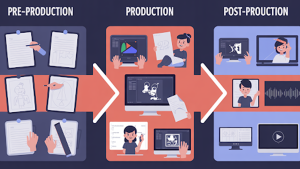Have you ever stopped to think about those fun, quick videos that break down ideas so easily? You’ve likely watched them in class, on a brand’s website, or while browsing your favorite social app. They’re known as animated explainer videos, and they do much more than just look good they help people understand things fast.
This guide shows what makes that magic happen and how to build an explainer that actually moves people to act.
What are Animated Explainer Videos?
An explainer video is a concise, purpose-built video designed to clearly communicate a concept, product, service, or process to an audience. It uses a combination of visual storytelling, such as animation, motion graphics, or live-action footage, paired with narration or text to break down complex ideas into easily digestible information.
Typically lasting one to three minutes, best explainer videos follow a structured approach: they present a problem, demonstrate a solution, and guide the viewer toward a desired action. Their effectiveness lies in combining cognitive and visual learning principles, making abstract or technical subjects understandable and memorable.
Popular Animated Explainer Video Styles
There are several proven animation styles. Choose the one that best fits your story and audience.
Motion Graphics Animation
Motion graphics use UI choreography, shapes, icons, and typography to convey abstract concepts and information in a clear, contemporary manner. When dashboards, metrics, or interface behaviour are central to your story, they are perfect.
Why Use Motion Graphics in Explainer Videos?
They’re efficient to produce, easy to localize, and highly modular, perfect for repurposing across websites, product pages, and social cutdowns. When your goal is product clarity, motion graphics elegantly show cause-and-effect: click here, outcome there.
Key Elements of Motion Graphics
A tight script, a consistent visual system (iconography, color, type), and transitions that carry logic rather than simply decorate. Sound design should be minimal but precise to punctuate key beats without competing with VO.
2D Animation
2D character and scene-based animation adds emotion and relatability. Characters personify your audience’s pain points and the transformation your solution enables.
Why Use 2D Animation in Explainer Videos?
Because viewers connect with people. When they see a version of themselves struggle and then succeed in 2d animation, the message lands harder. 2D animation is ideal for quick onboarding, internal culture, and brand storytelling.
Key Elements of 2D Animation
Readable silhouettes, expressive faces, and clear staging. Secondary motion (eye blinks, head tilts, hand gestures) adds life; restrained backgrounds keep the focus where it belongs.
Whiteboard Animation
Whiteboard animation videos simulate a hand drawing the narrative in real time. The linear reveal maps to step-by-step reasoning, which makes abstract logic easier to follow.
Why Use Whiteboard Animation in Explainer Videos?
Because it feels like someone is teaching you one-on-one. Watching ideas get drawn step by step makes complex topics easy to follow, builds trust, and sticks in your memory. Perfect for schools, nonprofits, and thought leaders who need clear, friendly explanations.
Key Elements of Whiteboard Animation
A cohesive visual metaphor, deliberate pacing between draws, and VO that leads logic. Limited, strategic color can highlight milestones or definitions without clutter.
3D Animation
3D animation introduces depth and realism. You can orbit products, explode assemblies, and reveal mechanisms that are hard to capture in live action.
Why Use 3D Animation in Explainer Videos?
3D stands apart by delivering true-to-life visuals with accurate scale, lighting, and materials, letting you orbit, explode, and section objects to show every angle and inner mechanism. It conveys the physical truth of complex machinery, medical devices, hardware, and architecture, how parts fit, move, and function in real-world scenarios.
Key Elements of 3D Animation
Accurate modeling, physically based lighting, and camera paths that reveal function. Clarity outranks spectacle especially in technical explainer videos, where labeled components and measured camera moves beat flashy spins.
What are the Pillars of a Great Explainer Video
1) Strategy Before Style
Before opening After Effects or Blender, agree on the communication outcome. What behavior should change after watching? That answer drives run time, style, CTA, and distribution plan. A clear explainer video strategy also avoids scope creep: if a scene doesn’t move the goal forward, it goes.
Quick framework:
- Audience: who and where?
- Problem: what tension do they feel?
- Promise: how do you uniquely resolve it?
- Proof: what makes you credible?
- Path: what should they do next?
2) A Script Made for Ears
Writing for the ear is different from writing for the eye. Use short sentences, active voice, and familiar words. Read aloud. If you run out of breath, your viewer will run out of patience. Replace technical clauses with clean cause-and-effect: “Click once, and your dashboard updates in real time.”
Pro tip: Start with the CTA. Knowing your destination helps you trim detours.
3) Visual Metaphors
| Concept | Example | Rule / Best Practice |
| Metaphors compress complexity | Data pipeline → liquid through valves; Security audit → gates/locks/checkpoints | Pick one metaphor family and carry it through to avoid cognitive thrash |
| Consistent visual logic | Same metaphor rules in every scene | Keep rules uniform across frames |
| Minimal on-screen text | Narration carries detail | Use fewer words on screen |
| Generous whitespace | Breathing room around key elements | Remove clutter; leave space |
| Clear focal path | Left→right or 1→2→3 eye flow | Guide viewers where to look next |
4) Pacing and Structure
Most explainers thrive at 60–90 seconds, but the real metric is idea density. Each beat should introduce a single idea, resolve it, and move on. Use a “breathing” moment after dense scenes let the music fill that space then accelerate into your CTA.
5) Audio that Guides Attention
VO is the spine; music and SFX are connective tissue. Use markers to align keywords with on-screen changes. Keep music in a complementary register so frequencies don’t fight the VO.
6) Accessibility and Localization
Burned-in captions improve comprehension, especially for mobile viewers watching on mute. Plan for translations early: avoid idioms, build text as editable layers, and keep UI scenes flexible for longer languages.
Why Consider Animated Explainer Video Services?
- Easy to Understand: Animation removes distractions and spotlights relationships that make a concept click. Viewers grasp value faster and retain it longer.
- Engages the Audience: Thoughtful motion, visual surprises, and crisp sound cues keep attention from the hook to the CTA.
- Versatile: From minimalist icons to rich character worlds, animation adapts to your brand voice and audience.
- Cost-Effective: Animation provides control, predictability, and reusable assets that allow you to work with a smaller budget than live-action shoots.
- Enhances Retention: Metaphors, synchronized VO, and progressive reveals boost recall by aligning what people see with what they hear.
- Increases Conversion Rates: Clear explanations reduce friction. When prospects truly understand “what it is” and “why it matters,” response rates rise.
- Boosts Online Visibility: Video increases dwell time and shareability, supporting SEO and improving landing-page performance.
- Easily Shareable: A single master can become vertical shorts, loopable booth visuals, sales-deck snippets, and help-center clips. Common signs your business needs an explainer video include repeated sales explanations, high product-page bounce, and clusters of “how it works” support tickets.
Use-Cases for Animated Explainer Videos
Product or Service Explanation
A 60–90 second overview clarifies your value proposition and sets up a single next step. Focus on the audience’s problem and the change your product unlocks.
Onboarding and Training
Standardize how you teach workflows, reduce ramp time, and cut back on repetitive support requests with targeted micro-animations.
Marketing and Advertising
Hook-first cutdowns fuel paid social and awareness. Brands with a strong sonic identity sometimes adapt animated music video services to craft rhythmic, ear-catching campaign assets.
Social Media Content
Caption-first loops perform well in silent feeds. Lead with the problem, showcase a visual payoff, and tease the CTA.
Customer Support
Replace dense articles with 30–60 second clips that solve one issue each. This improves satisfaction and deflection.
Investor Pitches
Turn your moat, TAM, and traction into visuals that stick: systems, models, and credible paths to scale.
Internal Communications
Align teams around strategy shifts with story-driven clarity, not slide overload.
Event or Conference Presentation
Loopable, VO-free versions communicate at a glance and draw booth traffic without audio.
What is the Animated Explainer Video Production Process
Pre-production
- Concept Development
Define audience, outcome, and the single takeaway. If distinctiveness is a priority, plan for video animation so your characters, UI, and transitions feel completely yours.
- Scriptwriting
Write for the ear: conversational lines, active voice, and minimal jargon. Each sentence should move the story forward.
- Storyboarding
Specify what appears, what moves, where the eye lands first, and how scenes connect. Treat transitions as storytelling, not decoration.
- Voiceover casting
Match tone to brand. Record a scratch VO to time scenes before moving to final.
Production
- Asset Creation
Create icons, characters, and UI scenes within a consistent design system. Organized layers save time in animation.
- Animating the Video
Sync motion to VO cadence with natural easing and purposeful overlaps.
- Sound Effects and Music Selection
Choose a music bed that supports rather than competes; use SFX to punctuate reveals and interactions.
- Recording and Syncing the Voiceover
Align keywords with on-screen changes for subliminal reinforcement and better recall.
Post-Production
- Editing and Refining the Animation
Trim air pockets and remove visual noise. Review at 0.75× and 1.25× to catch pacing issues.
- Color Grading and Special Effects
Use contrast to guide attention; keep effects restrained and meaningful.
- Sound Design and Mixing
Normalize levels, duck music under dense VO, and test on multiple devices.
- Exporting the Final Video
Deliver platform-specific masters and preserve a reusable asset library for future cutdowns.
Work With a Trust Animated Explainer Video Production Company
Animator partner selection should be outcome-driven. Define the goal, timeline, and approval path first; then review portfolios for storytelling clarity, not just visual polish. Ask for a discovery session, a sample storyboard, and a rough animatic before committing.
Choose the Best Animated Video Production Company by seeing how they handle your brief from day one.
- Do they push for clarity and tighten the message?
- Do they recommend a shorter runtime to keep attention?
- When a metaphor gets too clever, do they offer simpler alternatives?
The right partner challenges assumptions backed by data and real experience so your story lands cleanly and confidently.
FAQs
How long should an animated explainer video be?
Most top-of-funnel explainers land between 60–90 seconds; mid-funnel demos can stretch to 2–3 minutes if every beat earns attention and advances comprehension.
Which animation style is best for software products?
Motion graphics often lead to UI and data stories because type, icons, and transitions mirror interface logic. If hardware or spatial processes are central, consider 3D; for empathy and journeys, choose 2D.
Do we need a voiceover if most viewers watch on mute?
Captions are vital for silent feeds, but VO boosts clarity and recall on owned channels and sales calls. Many teams produce both a captions-first and a VO-led version.
How do we measure success beyond views?
Tie the video to behavior: time-on-page, CTA clicks, demo requests, qualified pipeline, feature adoption, or reduced support tickets. Compare 30–60 day pre/post metrics to isolate impact.
What’s a realistic timeline and process?
Plan 4–8 weeks depending on scope and review cycles: brief → script → storyboard → animatic → animation → mix → masters. If you need a partner who keeps speed and quality in balance, AnimatedVideos.co can run parallel tracks (asset build and VO timing) to hit deadlines without sacrificing clarity.
How should we vet potential studios quickly?
Ask for one storyboard sample, a rough animatic timeline, and a client reference. Reading a recent user review about hiring animated video agency partners reveals communication style during revisions and after launch.
Can we reuse animation assets for future campaigns?
Yes. Request source files, a mini style guide, and a library of reusable scenes so you can spin out social cutdowns, help-center clips, and event loops quickly.
Is 3D overkill for most explainers?
Use the simplest style that achieves clarity. 3D excels for hardware and spatial narratives; otherwise, 2D or motion graphics may be faster to produce and easier to localize.
What’s the best way to prevent stakeholder overload?
Establish revision caps per stage and designate a single approver for final calls. A seasoned studio like AnimatedVideos.co also brings tight feedback practice and clear artifacts (boards, animatics) that keep momentum.
Conclusion
Great explainers aren’t about fireworks; they’re about engineered understanding. Start with a sharp outcome, write for the ear, pick a style that serves the story, and protect clarity in every frame from storyboard to sound mix. Measure what matters (behavior change, not just views) and repurpose your master into formats that work across the funnel.
If you’re ready to produce an explainer that lifts comprehension and conversion, AnimatedVideos.co can help plan, create, and scale a video system that keeps working long after launch.




